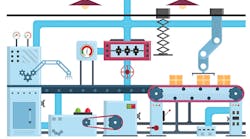Using Automation to Combat the Impending Labor Shortage
Carriers and third-party logistics operators (3PLs) have warned for years of an impending driver shortage, and now it is becoming clearer that this is a symptom of a much broader labor shortage facing the logistics industry that will impact drivers, dispatchers, and warehouse and dock workers.
As a result of many shippers outsourcing their logistics operations or utilizing third-party staffing agencies, they have become a layer removed from the labor market and might be unaware of the impending challenges on the horizon. The silver lining is that the labor shortage could push the logistics industry to evolve at an unprecedented rate — and present an opportunity for firms to gain a competitive advantage if they are willing to innovate and adapt quickly.
Tightening Labor Market
As the economy in North America continues to rebound, we expect the labor pool for drivers and material handlers to tighten as workers transfer back into higher-paying positions in competing industries. The current political environment in the U.S. is pointing toward a crackdown on undocumented workers, which will have a negative impact on the contract labor force. Also, an increased minimum wage could tighten the pool of available laborers as people transition into less physically demanding positions with comparable pay.
Warehouse of the Future
In addition to the economic and political pressures that make it difficult for 3PLs to find and keep labor, so too will evolving customer expectations. Customers of logistics services expect higher levels of service for lower costs. As a result, 3PLs are providing more and more value-added services such as assembly.
Kitting and converting of subassemblies into finished goods remains strong due to the pressure to quickly convert and ship an item the same day. For example, the custom sports apparel business does extensive embroidery and screen printing as an outbound service prior to shipping.
The warehousing operations of the future are more likely to resemble light industrial manufacturing operations as opposed to traditional warehouses. This transformation will require the warehousing workforce to become more skilled as they expand past their traditional role of picking and packing inventory for shipment.
Impact of E-Commerce on the Supply Chain
Several other trends have pushed the supply chain function to execute increasingly complex customer requirements. The rise of e-commerce has placed a new emphasis on last-mile delivery, and while traditional supply chains are adept at moving materials through hub and spoke networks to meet production schedules, there have been growing pains as networks transform to meet new customer expectations of same day delivery for retail goods via Amazon and its competitors. Tomorrow’s logistics work force will need to be skilled at designing, implementing, and executing quicker and more flexible network operations.
E-commerce has also shifted supply chain visibility from a beneficial perk into a necessity, as both retail and industrial consumers of logistics services expect to track and trace shipments at any and all points through the supply chain. This will require a workforce that is comfortable operationalizing, navigating, and mining data contained within integrated systems, in conjunction with implementing the traditional transportation and warehouse management solutions. Similarly, automation is driven by technology, equipment and software, and generates massive amounts of data. This will drive labor demand for IT resources, analysts and data scientists.
Automation of the Work Force
Similar to the trend of manufacturing coming back to the U.S. and becoming cost competitive via automation, the supply chain of the future will be highly automated.
Shipping docks are seeing wider adoption of self-guided vehicles to stage and load product. Wholesale distributors who used to be primarily pallet pick operations with lean labor staff have adapted to customer demands and moved away from pallet picking into a piece picking environment. This has created a demand for more technologies that can mechanically pick an individual item and for robotic picking. Automation will allow the warehouse of the future to handle more materials, provide more services and operate with less labor.
The warehouses of the future are also more likely to be staffed by engineers as opposed to unskilled laborers. Given the advances in automation, a warehouse in the near future will be staffed by a small cadre of highly skilled employees who operate and repair complex machines, rather than a high number of manual workers picking product and loading trailers.
Four Tips to Harness the Power of Automation
In the short term, implementing technology, automation, and innovation into your supply chain will be a competitive advantage. In the long term, it will become a barrier to entry for other firms that fail to transform their supply chain and find themselves unable to compete.
Assuming a supply chain’s processes are already in order, there are four key factors to harness the power of automation:
- Change the perception of driver and warehouse positions from one with limited growth opportunities to a launching pad for a career in operations management. UPS attributes much of its success in transforming from a package delivery firm to a global leader of logistics services with its tradition of internal advancement into management.
- Shift the view of warehouse labor as a cost of business into a competitive advantage. As the labor required to operate the warehouses of the future become more flexible and skilled, retention of good employees becomes more important.
- Embrace technology and automation now. If you wait, you might not be able to react quickly to the evolving demands and preferences of your customers. While the specific solutions will inevitably change in the future, the skill of being able to quickly identify and adopt solutions will serve you well in the future.
- Invest in talent in parallel with implementing automation solutions. The best solutions in the world fall flat without people who have the technical aptitude and analytical acumen to execute them.
While the impending labor shortage may serve as an initial call to action to implement automation and other technology solutions, the market will ultimately reward firms that react and adapt quickly to evolving customer demands. Supply chains across all industries must address the technology gap by becoming skilled at identifying, implementing, and operating automation and other innovative technologies.
In parallel to applying technology solutions, the logistics industry must also find, develop, and retain employees who understand and embrace technology. Automation is likely to serve as a solution to the shortage of unskilled labor but will also create new opportunities and challenges associated with attracting a new type of work force.
Joe Vernon is a senior manager in the supply chain technology practice at Capgemini, a global leader in consulting, technology and outsourcing services. Jeff Hughes is a managing consultant at Capgemini Consulting, the global strategy and transformation consulting arm of the Capgemini Group.




